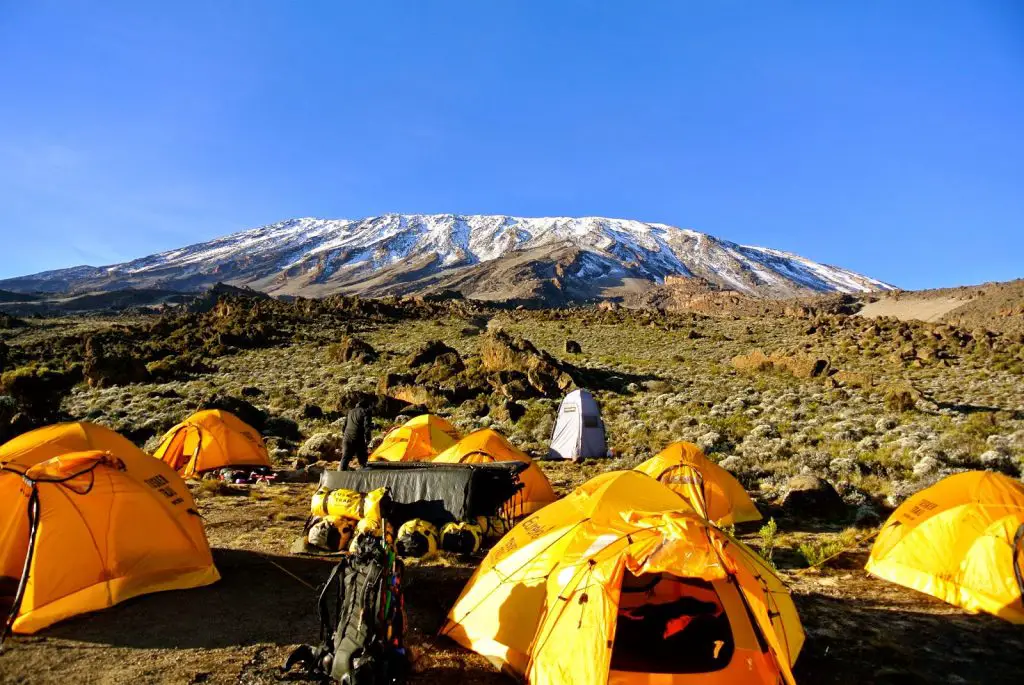This article is the third in a new series about my recent Kilimanjaro climb. In the days ahead, I’ll be sharing several articles about the experience to help readers prepare for a potential trek of their own in the future. Read Part 1 and Part 2 respectively.
As many of you know, my recent trip to Kilimanjaro was not my first visit to the mountain. I first visited the tallest peak in Africa back in 2007, climbing with a local guide service on what could best be described as an adequate, but no-frills, expedition. That operator – who shall remain nameless – was solid in every way, and I had few complaints than or now. But this time I went with Tusker Trail, the leading guide service on Kili, and the difference was like night and day. While both companies offer customers the opportunity to stand at the Roof of Africa, the journey to get there was a very different one.
When I started working with Tusker on the Climb for Valor project I was immediately struck with how professional the company was at every stage of the process. Not only did the Tusker staff provide plenty of pre-trip information to have participants as prepared as possible for conditions on the mountain, they also gave us extensive gear packing lists and recommendations for medications and shots. They provide each of the members of the climbing team with contact information prior to departure, and went above and beyond to ensure that everyone was comfortable with what lie ahead.
As you would expect, upon arrival representatives from Tusker were on hand to greet everyone at the airport and ensure that we all collected our bags and arrived safely at the lodge that served as home prior to the departure for the mountain. The staff that assisted us in Tanzania was just as friendly, helpful, and receptive as the those who had helped us back home prior to departure. In fact, the level of professionalism of every member of the Tusker crew was exceptional, ranging from customer service representatives to the guides and porters on the climb. It was truly impressive to see just how well trained each of these men and women were, and how dedicated they all are to making their customers happy and stratified.
There were lots of other little nice touches that came through as well. For instance, the Tusker chefs receive annual training from the Culinary Institute of America, and it shows. The food that was served to us while on the mountain was nothing short of extraordinary, with surprisingly tasty and diverse meals being delivered to the mess tent each and every night. Loss of appetite is a common side effect of being at altitude, and often you have to force yourself to eat more than you would typically like. That is an easier process when the food is actually delicious and appetizing.
Tusker takes the health of their climbers very seriously and twice a day we all had to submit to a medical check. During those sessions not only was our pulse and oxygen saturation levels checked, but we all answered a series of questions regarding how we were feeling. The guides also listened to our lungs to ensure there was no fluid build-up as well, which is a tell-tale sign of the early stages of pulmonary edema. Armed with excellent med training, the guides were also able to recommend some treatments to help keep us healthy on the trail, which in turn leads to a higher success rate for climbers.
Speaking of success rate, despite what you might read elsewhere Kilimanjaro is quite a challenging climb. In fact, only about 60% of all climbers who attempt to reach the top actually do so. But Tusker’s success rate is actually above 90%, which is due to a combination of preparation, extra days of acclimatization, and paying close attention to the health of their clients. Just about every stage of their climbing itinerary is built to give participants the best possible opportunity to reach the top, and it pays dividends in the long run.
Tusker has been operating on Kilimanjaro for nearly 40 years, and that experience shines through in every portion of the climb. From the gear that they use to the routes that they climb on, everything is well planned and thought out. The organization runs like a well oiled machine, allowing travelers to simply worry about each day’s hike, taking the climb in small segments until Summit Day arrives at last. The formula works incredibly well, and as a result the vast majority of our team was able to summit safely. We did have two members of the squad who had to be evacuated – a story that I’ll share soon – but even that process was handled calmly, professionally, and in the best possible way imaginable.
If a Kilimanjaro climb is in your future, I would certainly urge you to do a lot of research before deciding on a guide service. There are a lot of choices available, but they are definitely not all created equal. Personally, I can’t recommend Tusker highly enough, and I think you’ll find they are nearly impossible to beat in terms of service.
Latest posts by Kraig Becker (see all)
- Gear Review: The Xero Scrambler Mid is an Ultralight Hiking Shoe for Spring - March 1, 2023
- Gear Review: Yeti Roadie 48 Wheeled Cooler - August 18, 2022
- Kristin Harila Continues Pursuit of 8000-Meter Speed Record - August 16, 2022
